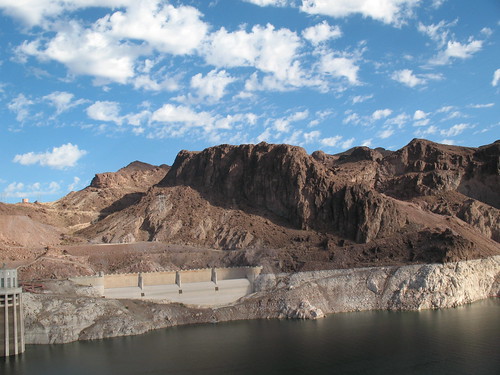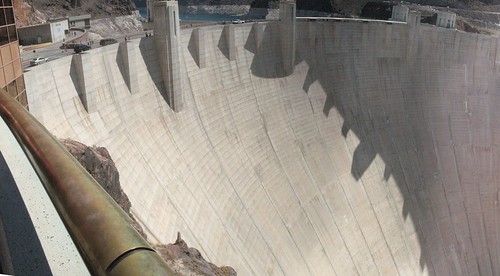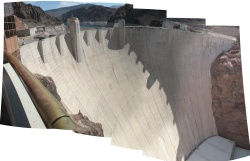Drainage Fail
Found this on the Failblog. Anyone want to take a guess and what confluence of events led to this?
Hoover Dam photos
The Technorama crew and spouses took a back stage tour of the Hoover Dam. The audio and video will be posted on the Technorama blog, but I took a couple of pics worth sharing.
This spillway has only been used once (or twice if you count testing). However, that one use spanned several months when flow from the Colorado river had filled Lake Mead and threatened to top the Hoover Dam. The high water mark can still been seen in this picture because the sides of the canyon were covered in calcification while it was under water.
The photo above doesn’t show the full size of the Hoover Dam. I turned my camera into portrait mode to capture more of the Dam’s face. But when I stitched the photos together, the whole picture doesn’t fit nicely into a rectangular frame. Click the image below to see the full-sized, uncropped version.
Building Stonehenge – This Man can Move Anything
Found this video through Mixx. Wally Wallington demonstrates how the stones of Stonehenge could have been transported and erected with fewer people than you might think. He stands a 19,000 lb. block on its end by himself using only leverage and gravity.
7 Engineering Wonders of the Modern World
7 Engineering Wonders of the Modern World: Contemporary World Record-Setting Construction
Found this story on Digg. I like the 1000’+ outdoor elevator, it is much more impressive than the Grand Canyon Skywalk. If only it weren’t in China.
The only thing that might top this is the Millau Bridge.

Photo source: Peter Welland
GPS photo tagging experiment
I recently bought a Garmin eTrex Vista Cx and like every new toy, I’ve got to play with it until something breaks. Until then, I’ll squeeze in some useful work. Using Robogeo to geocode the location info onto my photos, I’ve assembled a quick and dirty Google Map page. Most of these are just some shots taken from the car at various intersections to see if the location is close enough for more detailed uses.
Click here to go to map
Here’s some thumbnails of the pics I took. They link to the originals, which are rather large, especially the photostitched ones.
Marv
Penny bridges
I first saw coin structures like the ones atcoinstacking.com a couple of years ago, but it’s still a fascination for me. Like an arch, these only things holding the structure together is gravity and friction. But unlike that most ancient architectural element, there is no strategically placed keystone. These coin structures are also much more easy to build because the structure is relatively stable during construction.
I like the way this guy kept stacking more columns of coins on a bridge spanning three coin diameters. It’s amazing when you think about how the load is carried to the ground. Notice that in the picture before collapse, the bottom-most penny at midspan doesn’t appear to be carrying any of the load above it.
New cement conducts electricity like metal
A new type of cement mixes Titanium with the usual lime / alumina compound and heats it up to 1100 degrees Celsius. The resulting compound conducts electricity about as well as other metals at room temperature.
With Titanium in the mix, don’t expect to see this mix in your every day concrete pour. The article mentions a possible application as a substitute material for Indium which is used in plasma TVs and the like. This material is going to find a home inside of an iPod or cell phone probably.
All in all, it reminds me of electrically conducting clay polymers but with the novelty of being made with portland cement.
World’s Largest Treehouse
Alnwick Garden: World’s Largest Tree House via Digg

Photo source:Karen Withak
Alnwick Garden Treehouse Flickr photoset
6,000 sq. feet and includes a restaurant, gift shop and rope suspension bridges / walkways. Future plans include a tree based children’s play area.
Cool skyscrapers
Top 12 Skyscrapers of the World via Digg
Not sure if they should count all of these, since over half of them aren’t finished yet. But, if these buildings live up to their renderings, they’ll be extraordinarily cool. Only two of them are located in the U.S. The really outrageously tall ones are in China or Dubai, and the 300 story monstrosity redefines the term pie-in-the-sky.
Marv






